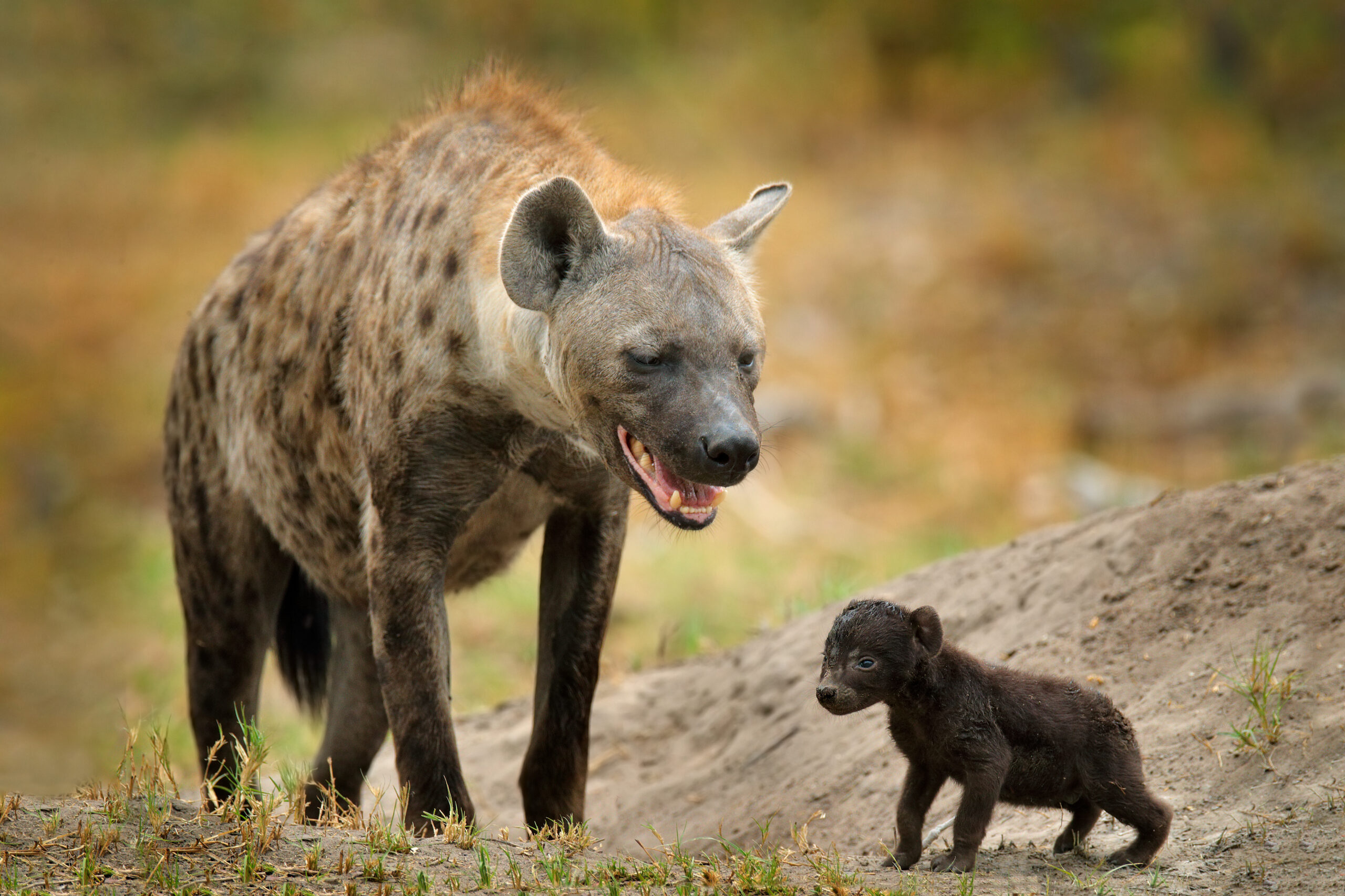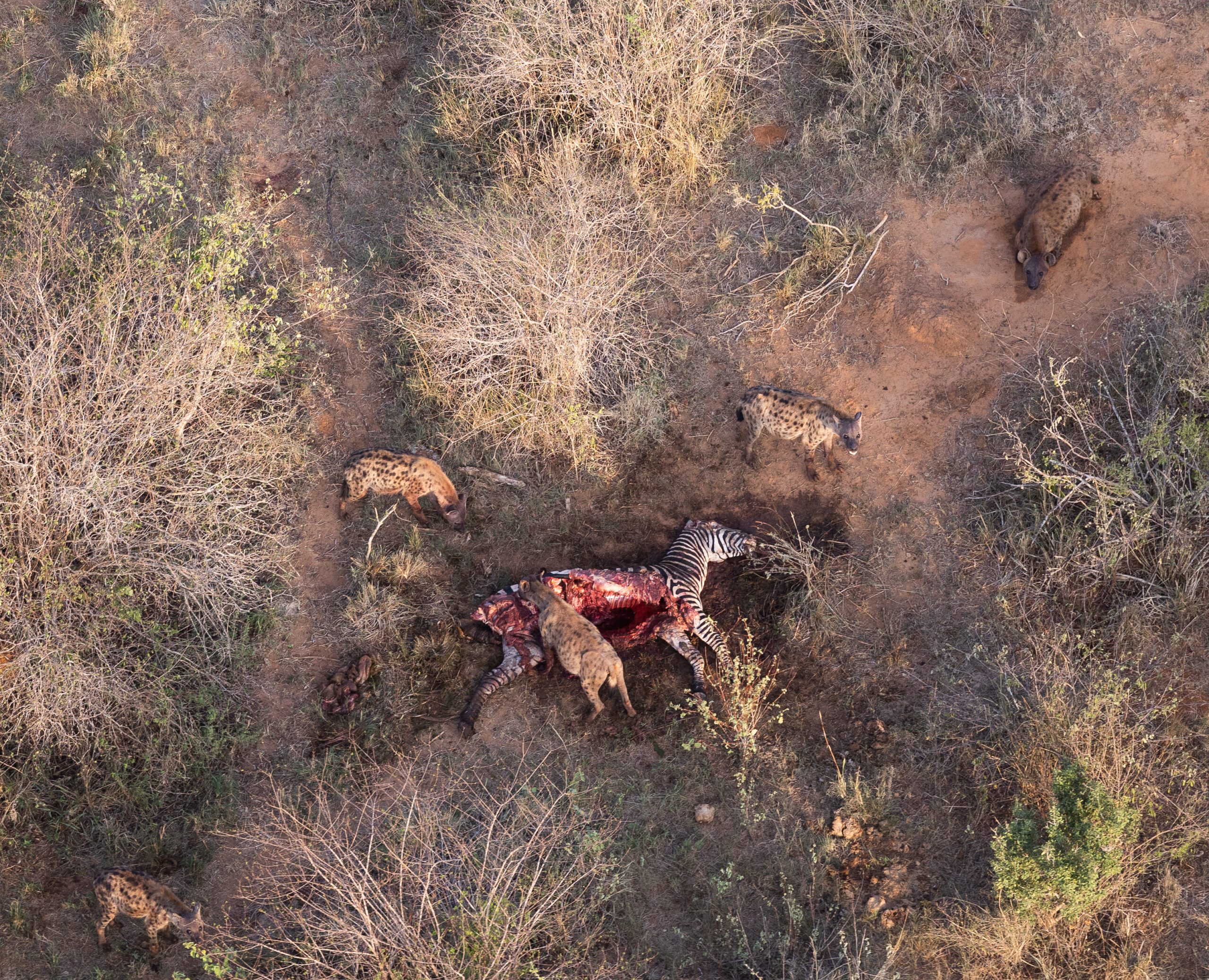Spotted hyenas (Crocuta crocuta) are among Africa’s most misunderstood carnivores. While often portrayed as scavengers, they are highly skilled hunters with complex societies unlike any other large predator. Most remarkable of all, hyena clans are matriarchal: females are larger, more aggressive, and socially dominant over males. This makes them one of the very few mammals where females consistently rule over males.
So why did hyenas evolve this way? The answer lies in a mix of ecology, evolution, and social structure.
What is matriarchy in hyenas?
In hyena clans, females rank above all males, regardless of age or size. Dominance is inherited matrilineally: cubs automatically assume the social rank of their mother. High-ranking cubs can even dominate unrelated adults.
Males, on the other hand, disperse from their birth clan once mature, joining other groups at the very bottom of the hierarchy. This matrilineal system ensures that power and resources remain in the hands of female lines.

Why are female hyenas more aggressive and dominant?
Aggression and Social Support
Female hyenas are more aggressive than males and more likely to be deferred to during conflicts. Because they remain in their natal clan for life, females build strong, lifelong networks with relatives and allies. Males, who disperse, do not benefit from this social capital and are generally submissive.
Hormonal theory: Do female hyenas have more testosterone?
For decades, scientists assumed female dominance was linked to unusually high testosterone. While female hyenas are exposed to elevated androgens (such as androstenedione) in the womb, research shows their circulating testosterone levels are not consistently higher than males’. Instead, fetal exposure to androgens likely masculinizes female cubs before birth, giving them both their aggressive tendencies and their unusual genitalia (the “pseudo-penis”).
This means dominance is not simply about hormones in adulthood, but about developmental biology that equips females to be dominant from birth.
Evolutionary and ecological context
Hyenas evolved to exploit a challenging ecological niche. Although they are very accomplished hunters, killing 60-95% of their own food, they have also evolved to scavenge significant amounts of their food. They have specifically evolved to crush bones to access marrow, an ability that requires formidable jaws and teeth.
Hyena cubs cannot fully use this bone crushing ability until around 18 months. Until then, they rely heavily on their mother’s milk and their mothers ability to secure soft meat at carcasses. This dependency likely reinforced selection for aggressive, dominant females who could win access to carcasses against competitors.
This helps explain why female hyenas are so protective and why their dominance is vital for the survival of their offspring.
Hyena social structure and kin dynamics
Hyena clans are among the most socially complex societies in the animal kingdom, rivaling primates in their organization.
-
Matrilines: Daughters inherit their mother’s rank.
-
Males disperse: Young males leave their natal clan to join another, where they begin at the bottom of the hierarchy.
-
Rank advantages: High-ranking mothers produce stronger, more confident sons, who often achieve higher rank in their new clans than sons of low-ranking females.
-
Alliances: Female cooperation within clans strengthens their control over food and breeding opportunities.
Hyenas are fiercely competitive animals, and this competitiveness is woven into every stage of their lives. Within a clan’s rigid hierarchy, higher-ranking individuals frequently assert dominance over those below them, often through aggression and forced submission. This constant testing of rank means that social status is never guaranteed—it must be defended daily. Injuries or illness can quickly push a hyena down the pecking order, as weakness is not tolerated. To survive in such a system, hyenas have evolved to be remarkably resilient, concealing pain or vulnerability to avoid being targeted. This relentless social competition keeps them sharp, robust, and acutely attuned to the dynamics of their clan.
FAQs About Hyenas
Why do female hyenas dominate the clan?
Because they inherit rank, form lifelong alliances, and are more aggressive, supported by developmental exposure to androgens.
Are female hyenas more aggressive than males?
Yes. Females initiate more aggression, while males are more submissive.
Do female hyenas have higher testosterone?
Not consistently. Their masculinization likely results from prenatal androgen exposure rather than adult hormone levels.
How does rank inheritance work in hyenas?
Cubs inherit their mother’s rank. Females retain this for life. Males must disperse and start again in a new clan.
Are hyenas hunters or scavengers?
Spotted hyenas are both. Despite their reputation, studies show they hunt the majority of their food, while also scavenging opportunistically.
How do hyenas give birth?
Female hyenas give birth through their elongated clitoris (pseudo-penis), a process that is extremely difficult and dangerous. Many first-time mothers lose their cubs during labor.
What do hyenas eat?
They eat a wide variety of prey: wildebeest, zebra, antelope, birds, reptiles, and carrion. Their bone-crushing teeth allow them to consume almost the entire carcass.

Spotted hyenas are one of nature’s most fascinating predators, shaped by an evolutionary path that placed power in the hands of females. Their matriarchal system is the product of biology, behavior, and ecology working together. Far from being simple scavengers, hyenas are complex, cooperative, and highly intelligent carnivores whose societies challenge our assumptions about dominance in the animal kingdom.
Understanding their female-led world not only reveals the hidden sophistication of hyenas but also underscores the diversity of survival strategies in Africa’s ecosystems.
Support Tsavo Trust’s efforts in protecting Kenya’s wildlife.

